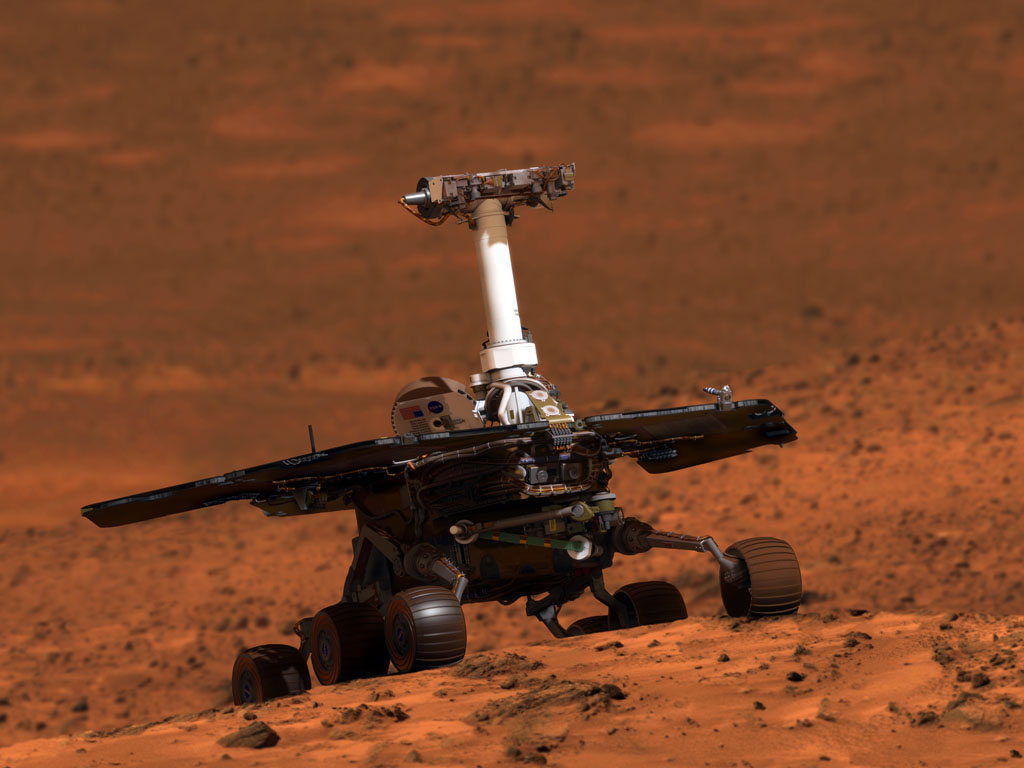On Sunday evening Nov. 2, at 7 pm CST,(in the US; check your local listings) the National Geographic channel will be showing a special documentary on the Mars Exploration Rovers. It’s called “Five Years on Mars,” and dramatizes the trials and tribulations of the rovers Spirit and Opportunity and highlights new scientific information on the planet’s geology and water history.
If you saw the “Mars: Dead or Alive” and “Welcome to Mars” shows, this one should be even better. The show will feature photo-realistic animation based on the actual landscape as captured by the rovers’ cameras, and interviews with MER PI Steve Squyres and others on the rover team.
Check out the National Geographic channel’s website that has some very spiffy downloadable wallpapers (like the one above), videos and other information about the show and about the rovers and their mission. Robert Pearlman at CollectSPACE.com also has a great overview of the show and an interview with Steve Squyres.
When the landed on Mars in 2004, they were expected to collect data over 90 Martian days, or “sols.” But ninety days have stretched into almost five years, and a short-term science mission searching for evidence of ancient water has turned into one of the greatest adventures of the space age. The rovers have trekked miles across hostile plains, climbed mountains, ventured in and out of deep craters, gotten stuck in sand dunes, and survived dust storms and mechanical failures.
Mark Davis, who also served as writer/producer/director of the award winning “Mars Dead or Alive” and “Welcome to Mars,” teams with legendary animator Dan Maas (IMAX “Roving Mars”)
Don’t miss it!


Definitely intend to watch this… which is saying something because I detest television.
They should call it “The Little Rovers That Could”. 😀
When the sun shines again, will it power up for more missions?
When the martian winter ends with the sun be able to power up the lander again to working order again?
After the martian winter will the phoeniz be able to power up once the sun hits it again?
Sorry it took me 3 times to figure out to leave a apologizxe for the invoniencence. But does someone have a answer to my quesiton??
Hi, do you know if this documentary will be released as a DVD? Will it be soon?
90 days turned into 5 years? Well if you have to make a huge miscalculation in spacecraft life this is the way I guess.
Stacy-
Engineers don’t expect the Phoenix lander to survive the winter. All the components will freeze solid and carbon dioxide ice will likely encapsulate the lander, probably breaking the solar arrays and possibly other things as well. But there is a “Lazarus” mode on the lander, that if it can, it will call home after the thaw, about a year from now.
But the Mars rovers, (which the above article is about) have survived the Martian winters. They are not at the North pole, and since they have the ability to move, they have spent winters in a sunny spot just basically sitting and staying “alive.” Who knows how much longer they’ll keep going…
Nancy
Nancy
The CGI efforts at portraying the adventures of the Pheonix Lander are highly skilled and clever. In fact I would suggest that they are so good and so attractive, that we very rarely see a “real” photo (unaltered or with true natural colour applied). In what way are the CGI images ‘tailoring’ our interpretation of what the Lander sees and does? The lander is taking thousands of high resolution images, why are none used in the media, or here?
I find this quite annoying, I would much rather see the “real” images.
There is a program right after the Mars Rovers one titled Calling All Aliens.
Watch it, or risk being unprepared for the invasion.
The ads for the Mars Rover program were trying awfully hard to make Spirit and Opportunity seem like a certain robot from a certain Disney-Pixar film released this past summer.
Especially the wistful image of one rover staring up at a starry night sky on Mars. I was waiting for a more advanced white bullet shaped probe with a female personality to show up. :^)
>Don’t miss it!
Great — put it on a channel where we can’t see it.
NatGeo will have it out on DVD in no time, I am sure.
And YouTube will probably have it before them.
Wish I could watch this show, but it is only on the premium satellite package here. All future landers should be able to move to prolong their lives and increase research areas. Just think of the bonuses Phoenix could have experienced if it could have moved just over the next hill or re-oriented to maximize the solar cells. I know that the next big one is going to be able to move (if it gets there and lands safely and works correctly and nothing political gets in the way).